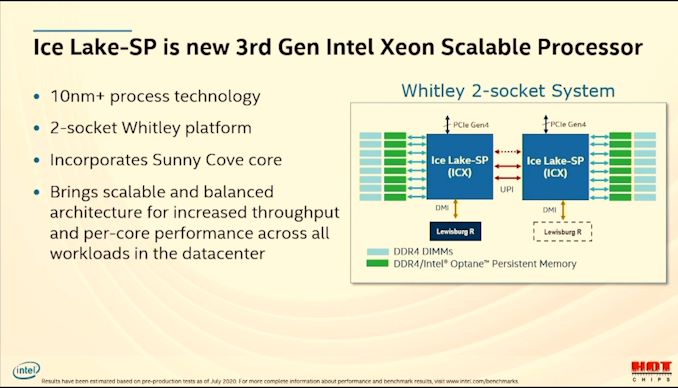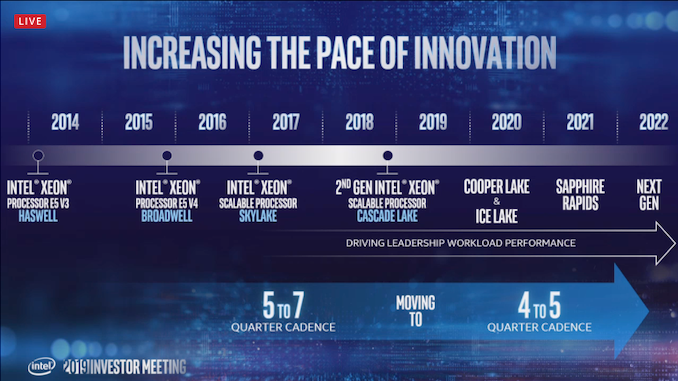Intel Ice Lake Xeon Scalable Shipments To Date: 30 Customers, 100k+ Units
by Dr. Ian Cutress on March 9, 2021 1:15 PM EST- Posted in
- CPUs
- Intel
- Xeon
- Enterprise CPUs
- 10nm
- Xeon Scalable
- Ice Lake-SP

We’re gearing up for a busy time when it comes to server announcements, with the recent news that AMD will be launching its next generation platform on March 15th, but also we are expecting Intel to disclose its Ice Lake Xeon Scalable platform sometime soon as well. To that point, in an on-the-record discussion I had today, Intel disclosed some interesting numbers about the state of Ice Lake Xeon Scalable deployment.
The usual fare when it comes to enterprise processor launches is that the key customers have already had the hardware in hand for at least three to six months, if not more. These key customers, usually hyperscalers, pay in advance for thousands of units to help deploy their infrastructure. They use the hardware to optimize their code, but also help the processor manufacturer test for bugs in early silicon, and then build out their infrastructure when it's ready. This has been the way for server processor deployments for over a decade or two, and for the upcoming launches, both AMD and Intel have disclosed that they’ve been in high-volume manufacturing of their latest products for some time now, with key customer deployments already taking place.
Finding numbers for how big these deployments prior to launch is often tricky. Even the order of magnitude is somewhat hard to decipher – these companies could be deploying hundreds, thousands, perhaps millions of processors well before the official public launch. A lot of it comes down to production availability, and optimizing for the customers that matter most first, before moving out to the main launch and general availability.
So cue my surprise that today, in an on-the-record call with Intel SVP and GM of the Xeon Memory Group Lisa Spelman, as we were discussing Intel’s enterprise strategy as it relates to offering complete solutions, open source libraries, and automatic optimizations on the latest feature set, some numbers were given. Lisa stated that, to date, Intel has shipped 115,000 units of Ice Lake Xeon Scalable to 30 of its key advance customers.
It’s hard to gauge what sort of time frame these deployments were made over – Intel has recently stated that through 2020 it was able to double its silicon production capacity, with its 10nm product lines getting the best percentage boost in that metric. However, Intel originally stated that it was sampling Ice Lake Xeon with key customers as far back as May 2019. With high volume manufacturing starting in Q4 and into Q1, there is obviously an ecosystem and supply chain inside Intel designed to churn out working silicon and put it into the hands of customers. It’s hard to decipher if this 115,000 number is better or worse than previous launches, due to lack of data, however it is a substantial amount of silicon to ship in advance of a full launch and wider general availability.
Lisa also stated that enabling their ecosystem with full stack solutions, building on raw performance with optimized codebases, is going to be a critical part of Intel’s strategy as it rolls out Ice Lake and future generations of Intel Xeon Scalable, alongside Intel’s other adjacent product lines (FPGA, networking, Optane DCPMM, SSD, AI accelerators). This means that alongside discussing generational updates of the key components, the discussion is also fundamentally driven by the platform as the sum of its parts.
There was also mention of the desire to enable a regular expected cadence of underlying performance improvements generation on generation, coupled with tools to accelerate customer workload that are easier to use and open source. This is being enabled as a core part of how Intel’s enterprise divisions have been architected over 2020. That includes enabling the wider ecosystem outside Intel with optimizations that used to be under Intel license, as well as pooling updated improvements for other open source solutions with the community.
Intel hasn’t formally disclosed a launch date for its upcoming Xeon Scalable 3rd Generation Ice Lake processor family, simply stating in January that it will be ‘in the coming months’. When it does, be sure to read about all the fine details here at AnandTech.
Update: Just some back of the napkin math here. Intel's middle die-size HCC on Skylake Xeon Scalable was ~480 mm2, with a production rate of 108 per wafer, assuming perfect yield. Let's work on the assumption that this would be a good die size for Ice Lake Xeon (more cores, denser 10nm process). If Intel's defect rate for 10nm was as good as TSMC's N7, for which we know the latter to be a rate of 0.09 defects per cm2, the actual yield would be 71 dies per wafer, which equates to 66%. If Intel was extracting 71 dies per wafer, then 115,000 dies would be around 1620 wafers. We don't know at this point if Intel is absorbing some of those defects by having more physical cores on the die than will be offered, and this doesn't take into account reduced die count configurations (e.g. a 20 core part from a 28-core die). But it's an interesting number.
Related Reading
- Hot Chips 2020 Live Blog: Next Gen Intel Xeon, Ice Lake-SP (9:30am PT)
- Intel Confirms 10nm Ice Lake Xeon Production Has Started
- Intel Xeon Update: Ice Lake and Cooper Lake Sampling, Faster Future Updates
- An Interview with Lisa Spelman, VP of Intel’s DCG: Discussing Cooper Lake and Smeltdown













30 Comments
View All Comments
mode_13h - Monday, March 15, 2021 - link
Yeah, consoles were a stable income stream through years when AMD was hemoraging money.And making console chips for MS gives AMD some theoretical advantages in better Direct3D support for their GPUs and MSVC support for their CPUs.
mode_13h - Monday, March 15, 2021 - link
I'm pretty sure AMD doesn't buy the wafer capacity for console chips. AMD only designs them, by contract, for Sony and MS. I think Sony and MS probably deal with TSMC, directly. At least, when it comes to negotiating and purchasing wafers.And no matter who designs them, they're still going to consume fab capacity, because Sony and MS don't seem ready to stop making consoles any time soon.
mode_13h - Monday, March 15, 2021 - link
And even if Sony & MS did buy wafers through AMD, you've got to imagine those wafers were purchased YEARS in advance. AMD would be under contractual obligations and couldn't just turn around and decide to use them on Zen3 cores for Milan, instead.However, I know that MS and Sony control the IP for their respective console chips, and they're big enough customers that I don't see why they wouldn't deal with fabs, directly.
eastcoast_pete - Wednesday, March 10, 2021 - link
Actually, that (prediction of demand, project management of manufacturing) is exactly what the business side (marketing, forecasting, production management) of any company is supposed to do; doesn't matter if that chip maker is AMD, Intel or whatever. This mismatch of supply and demand will hurt AMD, and should have consequences at senior levels.mode_13h - Thursday, March 11, 2021 - link
> and should have consequences at senior levels.Yeah, bonuses. No one could've accurately predicted the past year. There were so many variables & unknowables, and it's not like TSMC had an abundance of fab capacity that AMD simply passed up, at the very last minute.
For AMD, the real disaster would've been getting caught with too much inventory on its hands, after paying absolute top-dollar for the wafers. Any shareholder lawsuits for AMD not doing *even better* than they have would be laughed right out of court.
Exotica - Tuesday, March 9, 2021 - link
So rather than getting mad over your pre-review of Rocket Lake, and blacklist you, instead they take the opportunity to speak to you and market themselves and their Ice Lake product, and show what they are doing and how they’re benefiting customers. Seems very professional to me.Exotica - Tuesday, March 9, 2021 - link
Good to know that 10 nm desktop parts are finally yielding and shipping in volume. Took 6 long years but at least they didn’t give up. Let’s see how they refine 10 nm and when they ramp 7 nm. Long live x86!McCartney - Tuesday, March 9, 2021 - link
do i want this or do i wait til next year for the dual socket pci-e 5.x variant? that's the real question.hopefully i'll have my DK05F by the time i make either purchase. i really cannot wait. been wanting a lili desk since the f1
McCartney - Tuesday, March 9, 2021 - link
i believe the platform i'm referring to is "sapphire rapids". some sites are saying sapphire rapids is still due out late this year, where they have an updated ETA for tiger lake as sept 2021 (realistic). so i assume i wait for sapphire rapids?mode_13h - Wednesday, March 10, 2021 - link
This is just weird. "show what they are doing and how they’re benefiting customers" ??? That's like beyond spin.And it's very much in Intel's interest to run interference ahead of AMD's big Milan launch. So I don't see this article as a favor to Anandtech, but rather just the usual PR game.